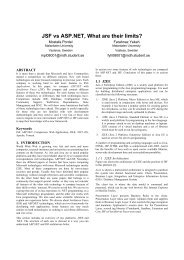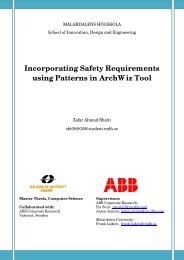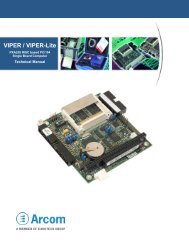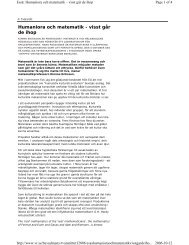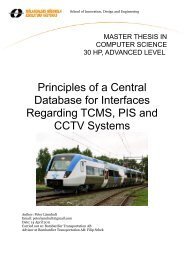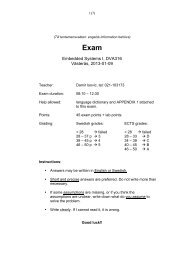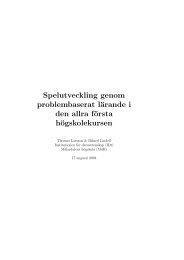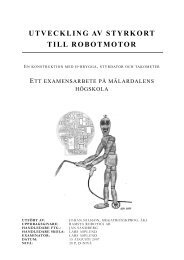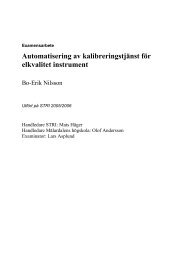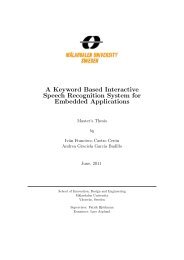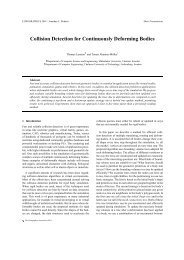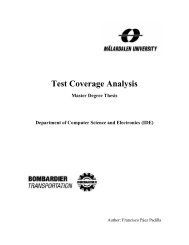CoDeSys on CCP XS for Bromma Conquip - Research
CoDeSys on CCP XS for Bromma Conquip - Research
CoDeSys on CCP XS for Bromma Conquip - Research
- No tags were found...
You also want an ePaper? Increase the reach of your titles
YUMPU automatically turns print PDFs into web optimized ePapers that Google loves.
Student<br />
Joel Ek<br />
Supervisor at CC-Systems<br />
Fredrik Löwenhielm<br />
Dok Nr<br />
1.0<br />
Date<br />
2006-08-08<br />
Rev<br />
PA1<br />
Säk klass<br />
F<br />
Filname<br />
Thesis.doc<br />
CODESYS ON <strong>CCP</strong> <strong>XS</strong> FOR BROMMA CONQUIP<br />
PRELIMINARY STUDIES<br />
In order to get an understanding of how to carry out the thesis I required some background<br />
in<strong>for</strong>mati<strong>on</strong>. From <strong>Bromma</strong> C<strong>on</strong>quip AB, the company <strong>for</strong> which the thesis is per<strong>for</strong>med towards<br />
I needed in<strong>for</strong>mati<strong>on</strong> about the system they are using today. CCS developed this system so this<br />
was of course not a problem.<br />
A better understanding of <str<strong>on</strong>g>CoDeSys</str<strong>on</strong>g> was also essential when this tool was completely new to me.<br />
So the preliminary studies have been per<strong>for</strong>med by reading documents and user manuals <strong>for</strong> the<br />
systems. Tests of the different software tools, both those used in <strong>Bromma</strong> C<strong>on</strong>quips system and<br />
<str<strong>on</strong>g>CoDeSys</str<strong>on</strong>g> have also been c<strong>on</strong>ducted.<br />
2.1 SCS 2<br />
The sec<strong>on</strong>d generati<strong>on</strong> of the Spreader Communicati<strong>on</strong> System (SCS 2 ) is the core in a <strong>Bromma</strong><br />
C<strong>on</strong>quip spreader. The hardware c<strong>on</strong>trolling the spreader is divided into several nodes and<br />
resides <strong>on</strong> both the spreader and the crane (fig.4), the number of nodes used depend <strong>on</strong> the<br />
spreader. At least <strong>on</strong>e is required, the Master that makes all the calculati<strong>on</strong>s and decisi<strong>on</strong>s <strong>for</strong> the<br />
spreader, it is located <strong>on</strong> the actual spreader. Then you can c<strong>on</strong>nect up to seven other nodes <strong>on</strong><br />
the spreader and up to four nodes <strong>on</strong> the crane. These slave 7 nodes act as remote I/O 8 to the<br />
master.<br />
Crane<br />
Slave 1 Slave IO c<strong>on</strong>nected to<br />
sensors and<br />
actuators<br />
Slave 1 Master<br />
Slave 1 Slave 1<br />
Spreader<br />
Figure 4:<br />
Graphical overview of the SCS 2 system<br />
The behaviour of the system is described by a number of software comp<strong>on</strong>ents and c<strong>on</strong>necti<strong>on</strong>s.<br />
The nodes <strong>on</strong> the spreader have I/O directly c<strong>on</strong>nected to the sensors and actuators <strong>on</strong> the<br />
spreader.<br />
A crane node could be interfacing the c<strong>on</strong>trol system or a m<strong>on</strong>itoring screen.<br />
The communicati<strong>on</strong> between the nodes is made through a C<strong>on</strong>troller Area Network (CAN)<br />
network. It is a multi master network that c<strong>on</strong>nects several electrical units. A message send <strong>on</strong><br />
7<br />
The slave sends its input values to the Master and then set output values according to received data from the Master.<br />
8<br />
I/O: Input and Output<br />
12 (55)



